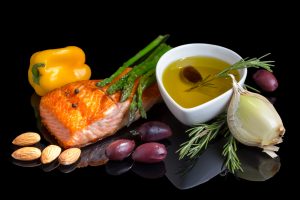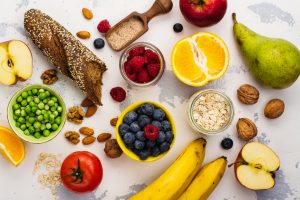You may have heard of an anti-inflammatory diet before. This type of diet has been linked to claims of benefits in heart health, digestive health, and even weight loss. Furthermore, a recent study has found a significant link between a pro-inflammatory diet and higher colorectal cancer risk.
What is inflammation?

Examples of anti-inflammatory foods.
Inflammation is a response that the body uses to protect itself from harm. For example, let’s say you cut yourself on a piece of glass. Your body will then release a stream of white blood cells to the rescue. These cells surround the harmed area and cause redness and swelling. This response is just those cells working to heal the injury. Then, as the cut heals, the inflammation will start to go down. This is called acute inflammation. Acute inflammation can also occur when viruses like the cold or flu enter your body.
Chronic inflammation occurs when such foreign substances enter your body repeatedly over time. Examples includes exposure to excessive numbers of fat cells from a poor diet, or nicotine from cigarette smoking. An example of chronic inflammation is with atherosclerosis, or hardening of the arteries. The body protects excessive fat plaques in the vessels from getting into the blood by building them up on the arterial walls. Over time, this can lead to conditions such as high blood pressure and heart disease.
What is an anti-inflammatory diet?
An anti-inflammatory diet includes foods that contain substances that can fight inflammation. Some anti-inflammatory foods include:
- omega-3 rich foods such as fatty fish like salmon, olive oil, olives, nuts, and avocado.
- brightly colored fruits and vegetables such as tomatoes, carrots, and berries that contain antioxidants such as lycopene, beta-carotene, and anthocyanin, respectively.
- coffee, which contains anti-inflammatory polyphenols.
- consume mostly minimally processed foods. The less ingredients on the label, the better since various additives and artificial ingredients may be pro-inflammatory.
On the other hand, a pro-inflammatory diet contains foods such as:
- red meat
- foods that contain trans or saturated fat such as processed meats like bacon, sausage, and deli meat, whole fat dairy products
- foods high in refined carbohydrates such as sugary drinks and candy or white breads, pastas, or rice
Inflammation and colorectal cancer risk
A recent study looked at the dietary data from a large group of adults enrolled in the Nurses’ Health Study. This data included food frequency questionnaires every 4 years and health-related information every 2 years. A 26-year study of this data found that those men and women with higher dietary inflammatory scores had higher risk of developing colorectal cancer. Therefore, researchers suggest that increased colorectal cancer risk may be seen in those who routinely consume a pro-inflammatory diet. In addition, researchers feel that those who are overweight or obese, or lean individuals who do not drink alcohol may benefit the most from strategies to reverse the effects of a pro-inflammatory diet. However, further studies need to be done to confirm such findings.
Other ways to fight inflammation
Even though an anti-inflammatory diet should be your first line of defense in lowering risk of colorectal cancer, the following strategies can also be helpful.
- Keep stress levels low by engaging in such practices as yoga, meditation, or massage on a weekly basis. Also, relaxation breathing, meeting with a counselor, or diffusing essential oils in your home or office can help lower feelings of stress.
- Exercise regularly at least 30 minutes a day for most days of the week. This does not have to be running or boot camp, and does not have to be all at once. Walking 5 minutes here and 10 minutes there can benefit overall health. Also, healthy side effects of exercise can include lower blood pressure, more controlled blood glucose levels, and weight management. All of these side effects can contribute to a lower state of inflammation in the body.
- Start taking certain supplements to help enhance the benefits of an anti-inflammatory diet such as turmeric, garlic, and vitamins A and C. These compounds in particular help boost immunity and healing. In addition, turmeric has been shown to have anti-inflammatory properties. Turmeric can be found in its pure form as a spice, used in teas, and also in supplement form such as with Vita Sciences Turmeric/Curcumin. Curcumin is the powerful antioxidant found in turmeric and is combined with Bioperine in this Vita Sciences blend to aid in optimal absorption.
-written by Staci Gulbin, MS, MEd, RD, LDN
Sources:
Harvard Health Publishing: Harvard Medical School (February 2017) “What is inflammation?”
Patton, MEd, RD, CSSD, LD, K. (July 1, 2015) “9 Diet Tips to Help You Fight Inflammation.”
Pevsner, H. (May/June 2012) “10 Ways to Reduce Inflammation” EatingWell.
Sears, B. (2015) “Anti-inflammatory Diets.” 34 Suppl 1:14-21. doi: 10.1080/07315724.2015.1080105.
Tabung FK, et al. (published January 18, 2018) “Association of Dietary Inflammatory Potential With Colorectal Cancer Risk in Men and Women.” JAMA Oncol. doi:10.1001/jamaoncol.2017.4844
 Sleep is a precious commodity in your busy life. Between work, taking care of loved ones, and running errands, it is a wonder you find time to sleep at all. However, it is important to make time for sleep because of all of the health benefits adequate sleep can provide. A recent study suggests that making a to-do list may help ease your mind so you can capture more sleep.
Sleep is a precious commodity in your busy life. Between work, taking care of loved ones, and running errands, it is a wonder you find time to sleep at all. However, it is important to make time for sleep because of all of the health benefits adequate sleep can provide. A recent study suggests that making a to-do list may help ease your mind so you can capture more sleep. Like millions of other people, you may be hoping to lose some weight in this new year. However, the confusing part may be what eating plan, or shall I say “diet,” should you choose to follow? There is so much information in the media today making all sorts of weight loss claims. They may all seem promising, but not all may provide you the nutrients you need to succeed long-term. However, a recent report found that the DASH diet may be the answer to get you to your weight loss goal.
Like millions of other people, you may be hoping to lose some weight in this new year. However, the confusing part may be what eating plan, or shall I say “diet,” should you choose to follow? There is so much information in the media today making all sorts of weight loss claims. They may all seem promising, but not all may provide you the nutrients you need to succeed long-term. However, a recent report found that the DASH diet may be the answer to get you to your weight loss goal. Every new year, many of us make resolutions to be healthier. Whether it be weight loss, exercising more, eating healthier, or managing stress better, such resolutions usually start off strong. However, by early spring, such goals usually lose steam and get pushed off until the next new year. That is why it is important to plan ahead before making any goals so you can make sure they are realistic and backed up with a lasting motivating factor. With such planning, you can make your new year’s goals come true this year and maintain such healthy habits for the long-term.
Every new year, many of us make resolutions to be healthier. Whether it be weight loss, exercising more, eating healthier, or managing stress better, such resolutions usually start off strong. However, by early spring, such goals usually lose steam and get pushed off until the next new year. That is why it is important to plan ahead before making any goals so you can make sure they are realistic and backed up with a lasting motivating factor. With such planning, you can make your new year’s goals come true this year and maintain such healthy habits for the long-term.
 On a cold winter’s day there is nothing better than a hot cup of tea to warm you up. Depending upon the type of tea you consume, this warm beverage could provide you with a variety of different antioxidants to help benefit your health. In fact, a recent study has shown that a cup of hot tea every day may help reduce glaucoma risk.
On a cold winter’s day there is nothing better than a hot cup of tea to warm you up. Depending upon the type of tea you consume, this warm beverage could provide you with a variety of different antioxidants to help benefit your health. In fact, a recent study has shown that a cup of hot tea every day may help reduce glaucoma risk. Fiber is an undigested macronutrient in food that comes in two primary forms. Soluble fiber dissolves in water to form a gel-like substance. This type of fiber has been shown to help lower blood cholesterol and glucose levels. Soluble fiber is found in foods such as:
Fiber is an undigested macronutrient in food that comes in two primary forms. Soluble fiber dissolves in water to form a gel-like substance. This type of fiber has been shown to help lower blood cholesterol and glucose levels. Soluble fiber is found in foods such as: If you have ever had a migraine headache, you know the pain is so intense that a trip to the hospital may be in store. In this case, the ER staff may use an opioid pain medicine as a first resort. However, a recent study has shown that this commonly used drug, also known for its addictive qualities, may not be the best choice for migraine relief.
If you have ever had a migraine headache, you know the pain is so intense that a trip to the hospital may be in store. In this case, the ER staff may use an opioid pain medicine as a first resort. However, a recent study has shown that this commonly used drug, also known for its addictive qualities, may not be the best choice for migraine relief. you have high blood pressure, heart disease may be the health concern most on your mind. However, high blood pressure can be a risk factor for more than just heart conditions. A recent study has found that women in their 40’s with high blood pressure have an increased risk of dementia.
you have high blood pressure, heart disease may be the health concern most on your mind. However, high blood pressure can be a risk factor for more than just heart conditions. A recent study has found that women in their 40’s with high blood pressure have an increased risk of dementia.